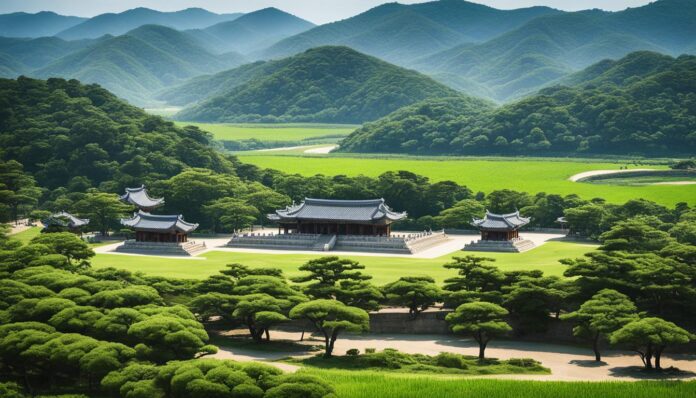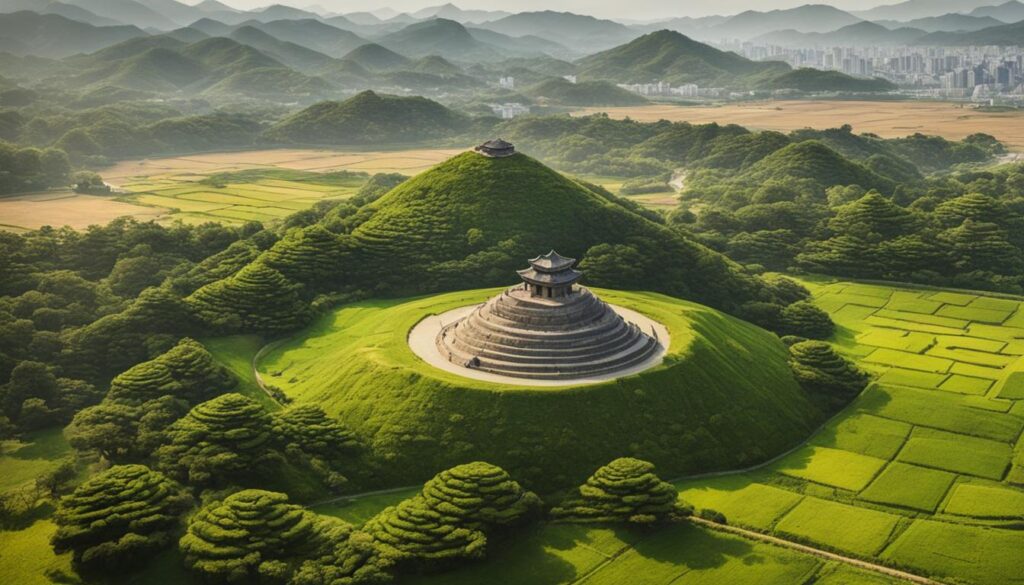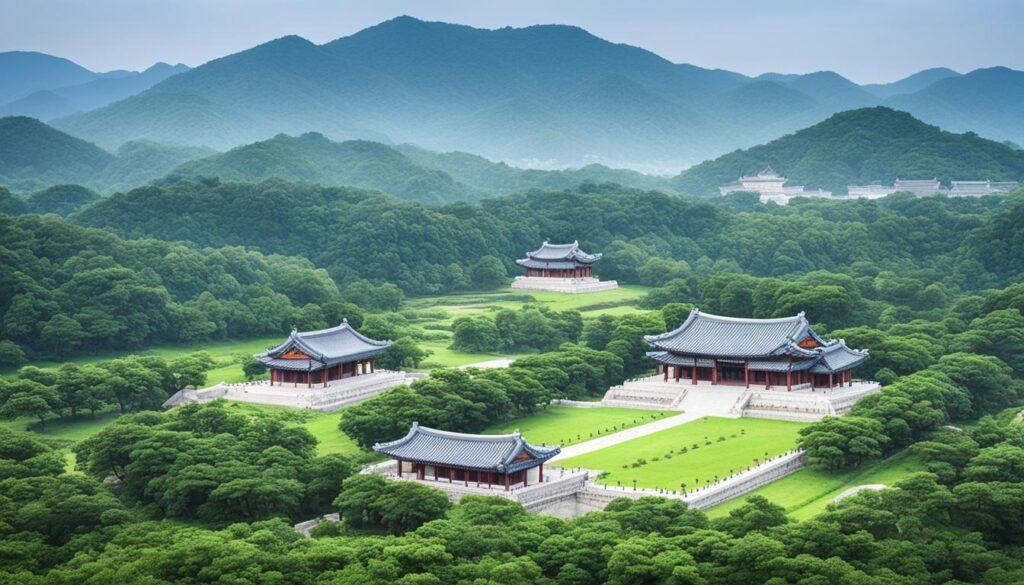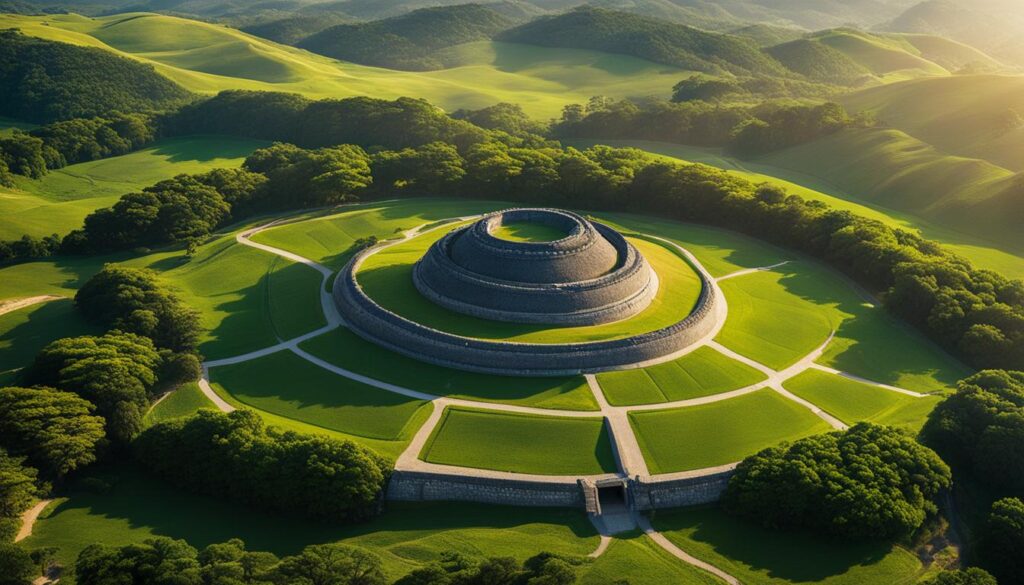Are you ready to unearth the hidden treasures of Gyeongju? Beyond the well-known Gyeongju Tumuli Park lies a world of ancient burial mounds and hidden royal tombs waiting to be explored. As a UNESCO heritage site, Gyeongju’s rich history and cultural significance are undeniable, and its ancient burial mounds are no exception. In this section, we’ll take you on a journey to discover the Gyeongju hidden royal tombs and burial mounds beyond Tumuli Park and explore the fascinating stories they hold.
With over 200 ancient burial mounds, Gyeongju boasts some of the most majestic and significant burial sites in Korea. From their striking architecture to their cultural importance, these Gyeongju hidden royal tombs and ancient burial mounds offer valuable insight into Korea’s past. Join us on this adventure to uncover the secrets of Gyeongju’s hidden treasure.
Exploring Gyeongju’s Rich Ancient History
As the ancient capital of the Silla Dynasty, Gyeongju holds a significant place in Korean history. It’s no wonder that Gyeongju is recognized as a UNESCO Heritage site, with its abundance of cultural treasures, including historical tombs and burial sites that provide valuable insights into Korea’s past.
Exploring Gyeongju’s ancient history is a must for any history enthusiast. The city is home to over 200 royal tombs and numerous burial mounds, each with a unique story to tell. These historical tombs and burial sites are not only visually stunning but also serve as a testament to the power and royalty of the Silla Dynasty.
Gyeongju Historical Tombs
The historical tombs of Gyeongju are architectural masterpieces that exhibit the skill and creativity of ancient Korean architects and artisans. The tombs, known as ‘tumuli,’ were built using a unique construction method that involved piling dirt onto a wooden frame, creating a mound that was then covered with stones.
Some of the most notable historical tombs include the Cheonmachong Tomb, which houses exquisite gold and bronze artifacts, and the Hwangnamdaechong Tomb, the largest tomb in Korea, with a perimeter of over 780 feet.
Gyeongju Burial Sites
In addition to the historical tombs, Gyeongju is also home to numerous burial sites that offer a glimpse into the customs and traditions of the Silla Dynasty. The Daereungwon Tomb Complex, for example, is a massive burial site that consists of over 20 tombs of varying sizes and styles.
Another fascinating burial site is the Seokguram Grotto, a man-made cave that houses a 3.5-meter-high statue of Buddha that was built in the 8th century. The cave’s interior walls are adorned with intricate carvings and are a true marvel of ancient Korean craftsmanship.
Gyeongju UNESCO Heritage Site
Gyeongju’s significance as a cultural and historical hub is reflected in its classification as a UNESCO Heritage site. The city’s rich history, combined with its abundance of cultural and historical treasures, makes it an ideal destination for anyone interested in ancient Korean history and culture.
Whether you’re exploring the historical tombs or the lesser-known burial sites, you’ll be immersed in the city’s ancient history and cultural legacy.
Uncovering Hidden Gems Beyond Tumuli Park
If you think Tumuli Park is the only place to explore ancient tombs in Gyeongju, think again! The city is home to numerous hidden gems waiting to be discovered by adventurous travelers like you. These lesser-known royal tombs and burial sites offer a peek into the rich history and culture of Gyeongju beyond its popular tourist attractions.
Start your journey by visiting the serene and picturesque Tomb of Hwangnam, located just five minutes away from Tumuli Park. This ancient tomb is believed to be the resting place of King Yuri, the 21st king of the Silla Dynasty. It boasts unique architectural features such as a square-shaped stone chamber and wooden ceilings.
Another hidden gem is the Cheonmachong Tomb, also known as the Heavenly Horse Tomb. This tomb is larger than most others in the area and is known for its lavish interior design. Visitors can observe exhibits showcasing the tomb’s treasures and learn about the cultural significance of the Silla Dynasty.
If you’re interested in learning about the life of royalty in ancient times, pay a visit to the Geumgwanchong Tomb. This tomb was built for an unknown royal, but the artifacts and treasures discovered within the tomb offer a glimpse of the luxuries enjoyed by the aristocracy during the Silla Dynasty.
Beyond these tombs, Gyeongju has a wealth of hidden treasures for you to discover. Venture off the beaten path and immerse yourself in the city’s rich history and culture.
The Significance of Gyeongju’s Royal Tombs
Hidden within the rolling hills of Gyeongju lies a collection of royal tombs and ancient burial mounds that bear witness to the glory and might of the Silla Dynasty. These Gyeongju hidden royal tombs are architectural marvels, showcasing the masterful craftsmanship and sophisticated design of the Silla civilization.
For centuries, these ancient burial mounds have stood as a testament to the power and royalty of the Silla Dynasty, and their cultural importance cannot be overstated. As a Gyeongju UNESCO heritage site, these royal tombs have been recognized as an invaluable part of the world’s cultural heritage, attracting visitors from around the world.
Explore the intricate details and significance of these majestic tombs, with each one holding a unique story of the Silla Dynasty and its legacy. From the mysterious Keyhole Tombs to the grandeur of the Cheonmachong Burial Mound, each of these royal tombs offers a glimpse into the magnificence of the past.
Learn about the fascinating features that make these royal tombs so special and appreciate the importance of preserving these incredible treasures for future generations to experience.
“The tombs of kings and queens are, in a way, a reflection of the country’s history and soul. Each element of the tomb is a reflection of the deceased’s character and the culture of the time.” – Park Young-soo, an expert on ancient tombs
Beyond Tumuli Park: Visiting Gyeongju’s Lesser-Known Burial Mounds
If you’re eager to explore more than just Gyeongju’s popular Tumuli Park, then you’re in luck. You can venture off the beaten path and find hidden gems that many visitors miss. Burial mounds in Gyeongju are an integral part of the region’s extensive history, and exploring them can provide you with a deeper understanding of the Silla dynasty and its customs.
Take the time to visit the ancient tombs in Gyeongju, scattered throughout the Gyeongju area. You’ll be rewarded with unique architectural structures that showcase the artistic and cultural expression of the Silla people. These sites play an essential role in preserving the legacy of the Silla dynasty, and their beauty cannot be missed.
Discovering the Lesser-Known Burial Mounds of Gyeongju
It’s not difficult to find the lesser-known burial mounds of Gyeongju. Some boast unique features that reflect a specific family’s background and societal status. One such example is the example of the Gold Crown Tomb located in Gyeongju. The tomb is a must-visit site and is sure to make an impression on anyone who dares to explore it. The surrounding area is peaceful and serene, perfect for enjoying a relaxing stroll.
Another fascinating site you can visit is the Royal Tomb of King Naemul, which is less grandiose than the well-known Daereungwon Tomb Complex but is nonetheless an important and serene area with a beautiful garden for you to admire.
If you’re interested in learning more about Korea’s rich history and culture, consider visiting the hidden burial mounds in Gyeongju. They offer a unique glimpse into ancient society and provide a stark reminder of the importance of history and conservation.
Exploring the Royal Tombs of Gyeongju
As you venture further into Gyeongju’s ancient history, the royal tombs become an essential part of your journey. These tombs served as the final resting places of Silla royalty, with complex burial rituals and architectural designs demonstrating the wealth and power of the dynasty.
The tombs’ designs vary, but many feature a large mound covering a stone chamber where the body was placed. Some of the tombs, such as the Cheonmachong Tomb, also contain valuable artifacts, including gold and pottery.
The rituals surrounding these tombs were just as important as the structures themselves. Common rituals included sacrificing horses, cows, and other animals before sealing the tomb, thereby providing companions for the deceased on their journey to the afterlife.
Today, visitors can explore several of these significant ancient sites. The most famous of these are the Cheonmachong Tomb and Hwangnamdaechong that provide a glimpse into the lives and rituals of the Silla Dynasty’s royalty. If you’re interested in experiencing the grandeur of these ancient tombs and the rituals surrounding deaths in the Silla Dynasty, make sure to add them to your itinerary when visiting Gyeongju.
Gyeongju’s UNESCO Heritage Site: A Journey Through History
When you visit Gyeongju, you’re stepping into a UNESCO heritage site that’s steeped in history and culture. These historic sites have made Gyeongju a must-see destination in South Korea, particularly for those with an interest in ancient history. The royal tombs and burial mounds scattered throughout the city offer priceless insights into Korea’s past and its ancient civilizations.
Throughout your journey, you’ll be able to immerse yourself in the beauty of these historic sites. The natural scenery surrounding these ancient structures is beyond compare. You’ll also get to uncover the rich cultural heritage of Gyeongju, which is an integral part of the Silla Dynasty legacy.
Exploring Gyeongju’s Cultural Treasures
As you journey through Gyeongju, you’ll uncover hidden treasures that have been recognized by UNESCO as a testament to cultural heritage. The ancient structures that dot the Korean landscape represent Korea’s past, and they’ve been beautifully preserved within the Gyeongju UNESCO heritage site. You’ll be able to explore these cultural treasures up close, admiring them in all their majesty.
The royal tombs and burial mounds in Gyeongju are integral elements of Korea’s cultural heritage. They represent an important period in Korea’s history, one that’s marked by imperial rule and rich cultural traditions. Gyeongju’s UNESCO heritage site helps us to remember, honor, and cherish this part of Korea’s history, ensuring it’s never forgotten.
Appreciating the Beauty of Gyeongju’s UNESCO Heritage Site
You’ll get to appreciate the beauty of Gyeongju’s UNESCO heritage site as you journey through the city. The ancient buildings, tombs, and burial mounds that have been preserved within the heritage site are awe-inspiring. You’ll marvel at their intricate design and the attention to detail that went into their creation.
The natural beauty of this region also adds to the charm of Gyeongju’s UNESCO heritage site. You’ll get to experience the sweeping landscapes, lush forests, and tranquil rivers that decorate this majestic place.
Preserving Gyeongju’s Cultural Legacy for the Future
The efforts made to preserve and protect Gyeongju’s cultural legacy are necessary to ensure that future generations can enjoy these historic sites in their original glory. The value of these ancient structures cannot be overstated, and it’s imperative that we cherish and take care of them.
Gyeongju’s UNESCO heritage site is a testament to the importance of preserving and protecting our cultural heritage. As you journey through this beautiful region, take the time to appreciate the significance of these ancient sites and their role in shaping Korea’s history and culture.
Unveiling the Secrets of Gyeongju’s Burial Sites
Journey back in time while exploring the ancient burial mounds and gain insight into the funerary customs of the Silla Dynasty. Marvel at the impressive architecture and intricate design of these hidden royal tombs that hold the secrets of Korea’s past.
Discover the burial sites in Gyeongju, which offer a unique perspective on Korean culture and tradition. These ancient burial mounds have played a crucial role in preserving the legacy of the Silla Dynasty for thousands of years.
Uncover the fascinating stories behind these sites and the people entombed within them. From legends of buried treasure to royal family feuds, each site has its own unique tales to tell.
“The tombs of Gyeongju truly are a window into the past, and a testament to the ingenuity and craftsmanship of the Silla Dynasty.”
Embark on a journey of discovery through Gyeongju’s burial sites and uncover their secrets for yourself.
Notable Burial Sites in Gyeongju
| Burial Site | Location | Features |
|---|---|---|
| Seoak-ri Royal Tomb | Southwest of Gyeongju | Ancient burial pit, valuable artifacts, Korean astronomical observations |
| Daereungwon Tomb Complex | Central Gyeongju | Largest ancient tombs in Korea, royal family members buried here, well-preserved wall paintings |
| Najeong Well Site | East of Gyeongju | Water well, well-preserved remains of a Silla Dynasty castle, ancient houses |
Beyond Tumuli Park: Must-Visit Ancient Tombs in Gyeongju
If you’ve already explored the popular Gyeongju Tumuli Park and want to discover more ancient tombs in Gyeongju, we’ve got you covered. There are numerous hidden and off-the-beaten-path sites to visit that showcase the cultural significance of this UNESCO heritage site.
One must-visit site is the Seobongchong Tomb, which is believed to be the resting place of a powerful Silla queen. This tomb is known for its unique stone carvings and stunning views of the surrounding landscape.
If you’re looking for something more off-the-beaten-path, head to the Nodong-ri Ancient Tombs where you can see multiple ancient tombs in one location. These tombs feature intricate carvings and stone structures that provide valuable insights into the customs of the Silla Dynasty.
Another must-visit site is the Daereungwon Tomb Complex, which contains some of the largest burial mounds in Gyeongju. This site is home to the Cheonmachong Tomb, which features stunning artifacts and treasures, including a beautiful golden crown.
Visiting these remarkable ancient tombs in Gyeongju is a great way to immerse yourself in the history and culture of this beautiful city.
Preserving Gyeongju’s Rich Heritage for the Future
Ensuring the preservation of Gyeongju’s hidden royal tombs and burial mounds is of the utmost importance, as they hold significant historical and cultural value for generations past, present, and future. The recognition of Gyeongju as a UNESCO heritage site highlights the importance of these ancient sites and the necessity to protect them from decay and damage.
Conservation efforts have been put in place to preserve these hidden treasures while allowing visitors to have access to them. These efforts encompass various strategies tailored to specific sites, including regular inspections and maintenance and using the latest technological tools and materials to protect and restore these architectural wonders.
Moreover, education and awareness programs have been initiated to inform visitors about the importance of preserving these sites and how they can contribute to their conservation. Through such programs, visitors gain a deeper appreciation of Gyeongju’s historical significance and a better understanding of the customs and rituals of the Silla Dynasty.
Preservation Strategies for Gyeongju’s Hidden Royal Tombs and Burial Mounds
| Preservation Strategies | Description |
|---|---|
| Regular Inspections and Maintenance | These measures aim to identify and address potential threats to the sites’ integrity, including natural erosion, water damage, and physical damage from human activity. |
| Conservation Materials | The use of advanced materials and techniques for maintaining the structures and artwork of these historic tombs, including modern materials to keep away microbes and pests. |
| Visitor Education Programs | These programs aim to raise awareness among visitors about the significance of these hidden royal tombs and burial mounds, and how important it is to conserve these treasures. It also notifies visitors about behavior restrictions around these sites to minimize human-caused damages. |
Preserving Gyeongju’s rich heritage is a collective responsibility that must be embraced by authorities, locals, and visitors alike. While it may be impossible to stop natural decay, there are ways to reduce the risk of damage and ensure that these ancient sites last for generations to come. By striking a balance between conservation and accessibility, these historical treasures can continue to be enjoyed by all.
Conclusion
You’ve now explored the hidden royal tombs and burial mounds in Gyeongju beyond the Tumuli Park and witnessed the immense historical and cultural significance of these ancient sites. Gyeongju’s rich heritage as the ancient capital of the Silla Dynasty has been beautifully preserved, making it a UNESCO heritage site and a treasure trove of historical insights.
From the royal tombs to the lesser-known burial mounds, you’ve uncovered secrets and cultural traditions that have been passed down through generations. The architectural features, rituals, and stories surrounding these burial sites have shed light on life in ancient Korea.
The efforts made to preserve these historical treasures are crucial in ensuring that they continue to be cherished for future generations. Gyeongju’s hidden royal tombs and burial mounds offer a glimpse into the past, but they also serve as a testament to the country’s rich cultural heritage.
So, whether you’re a history enthusiast, a culture buff, or simply a curious traveler, Gyeongju’s UNESCO treasure trove is waiting to be explored. Immerse yourself in the beauty, history, and charm of ancient Korea and witness the legacy of the Silla Dynasty firsthand.















































